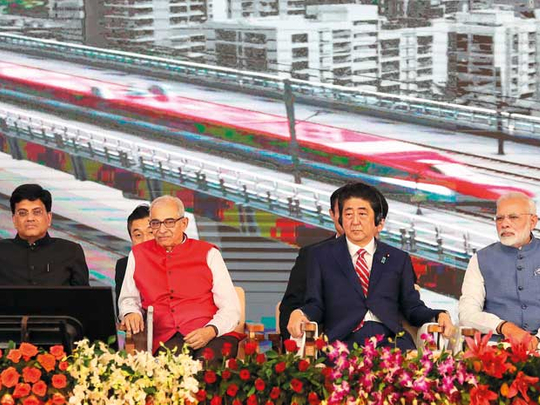
As part of his election campaign in 2014, Narendra Modi showed little interest in foreign policy focusing more on the issues of corruption and development. But after settling into South Block to take charge as the country’s 15th Prime Minister, he made several foreign trips selling the India growth story.
The pitch that Asia’s third-largest economy was open for business included a flashy new website, a new Make in India lion symbol and catchy phrases. It was part of a multimillion-dollar campaign to promote India as the foreign direct investment (FDI) hub for the world. Four years on what do the numbers reveal?
India’s FDI grew to $61.9 billion (Dh226.9 billion) in 2017-18, compared to $60.2 billion in the previous year, according to data by the Department of Industrial Policy and Promotion (DIPP). However, the pace of growth was muted at 3 per cent, the lowest so far compared to 8 per cent in 2016-17, 23 per cent in 2015-16 and 25 per cent in 2014-15, the year after Modi came into office.
“Though India’s FDI growth slowed down in 2017-18, it has not contracted in the past couple of years, indicating that the government’s efforts to improve ease of doing business and relaxation in FDI norms are yielding results,” says Dr Soumya Kanti Ghosh, Group Chief Economic Adviser, State Bank of India.
Given FDI has been such a focus area for Modi, the government has eased regulations in several sectors, including strategic ones such as defence, civil aviation and even politically sensitive sectors like retail. In August 2017, the government announced a consolidated policy to simplify FDI and promote investment and employment.
The drop in FDI growth can be partly attributed to a volatile global trading environment. “In our view, the hesitance [to invest] last year was more because of volatile conditions globally,” says Tushar Arora, Senior Economist, Treasury at HDFC Bank. “Uncertainty regarding oil prices, fears of immigration and protectionist policies, and rise in global interest rates are some factors that affected investor sentiment.
“India’s performance can be regarded as reasonably well in a not-so-good global environment.” Factors on the domestic front also played a role.
One year may be too short to assess the impact of India’s Goods and Services Tax (GST) after its chaotic rollout on July 1, but analysts say the uncertainty stymied investor confidence.
For the first time since 2015, the country slipped out of the list of the top ten economies on the global FDI radar, said a report by AT Kearney in May. India dropped three notches in 2018 after being ranked 8th in 2017 and 9th in 2016.
“The pace of growth was muted because of the transition to GST environment and consequent impact it had on businesses,” says Karthik Srinivasan, Group Head — Financial Sector at ICRA, the local unit of ratings firm Moody’s Investors Service.
Foreign inflows in India are usually through two routes: FDI and foreign portfolio investment (FPI), which is largely through stock exchanges. For a developing country such as India, FDI is prized over other forms of capital flows like the hot money of portfolio investments.
“With consistent current account deficit of the Indian economy, the financing of such deficit requires permanent long-term capital inflows to offset the negative pressure on currency and interest rates,” says Srinivasan. “While FPI is an important source of foreign currency flows, it suffers from sharp swings in the capital markets given the limited depth and breadth of India’s capital markets.”
Arora agrees. “What we need are committed investors, looking to invest on a long-term basis, thus providing a sustainable backing of money for large-scale projects,” he says. “Portfolio investments are short-term flows. To fill the wide gap of infrastructure funding, FDI is more important.”
Over the past fiscal year, FPI took the lion’s share of foreign inflows into India, touching $44.8 billion. Despite this, India has seen significant pick-up in FDI. The Japanese government has agreed to fund most of the $17 billion needed to build the Mumbai-Ahmedabad bullet train project.
Last year, the Asian Infrastructure Investment Bank (AIIB) approved a $335-million loan to finance an electric metro project in Bengaluru. Closer to home, the Abu Dhabi Investment Authority (ADIA) committed $1 billion for India’s National Infrastructure and Investment Fund (NIIF).
Elsewhere, the government allowed 100 per cent FDI in Idea Cellular following its merger with Vodafone, making Vodafone Idea the largest telecom operator in India. In May, Walmart acquired a 77 per cent stake in Flipkart for about $6 billion. In February, Ikea announced its plans to invest up to Rs40 billion ($612 million) in Maharashtra to set up multi-format outlets.
One of the biggest challenges for India in attracting FDI has been its insistence on transfer of technology, says Dr Ghosh. “We do not want FDI that comes into India to access the vast market and cheap labour pool without any benefit in the long run. The Japanese bullet train project has full transfer of technology. It is on these lines that we should proceed.”
Looking ahead, the outlook for FDI is promising as the investment climate continues to improve. “We remain optimistic about the continued growth of FDI in India, given the large opportunities that are present,” says Srinivasan.
“Improving the policy environment, further simplifying laws and opening up other sectors will ensure FDI volumes continue to pick up at a better pace in future.”


